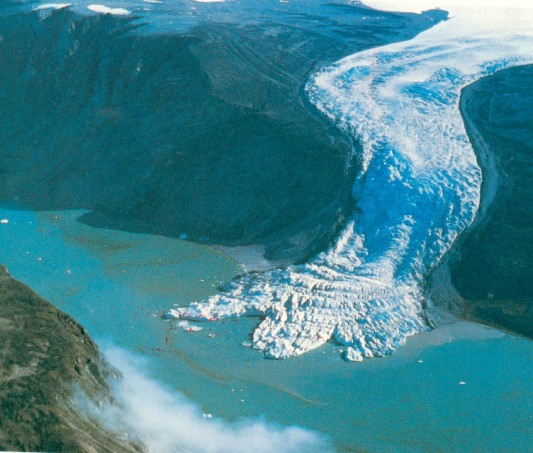
The thickness of the Greenland ice sheet was first measured by German Scientists in 1930. They set off explosives in holes drilled a few meters down into the ice. The forces of the explosion compressed the ice nearby. The compression set up shock waves that traveled in all directions. Waves traveling through the surface layers of the ice were detected by microphones spread out on the ice. Other waves went down through the ice. The solid rock beneath the ice reflected the waves to the surface, where the microphones detected them.
Mathematics tells us that rate multiplied by time equals distance. The scientists knew the distance waves had traveled at the surface and the time taken, so they could easily figure out the rate, or speed, at which the waves traveled through ice. Knowing rate and time, they could then work out the distance the waves had traveled between the surface of the ice and the rock below. This gave them the thickness of the ice.
The Germans found the ice near the edge of the ice sheet was about 1, 500 meters thick. It was even thicker in the middle of South Greenland. Sine World War II, scientists of many countries have made measurements. In parts of Greenland the ice is more than 3, 000 meters thick. In many areas the bottom of the ice is below sea level.
A fast, easy way of measuring ice thickness has been used recently. A plane flies over the ice sending out bursts, or “pulses”, of radio waves. The waves pass through the ice and are reflected by the underlying rock. Instruments in the plane measure the time it takes the waves to return to the plane.
Aside from the thick ice sheet, Greenland is also great for its mega canyon which was hidden for a long time already under the ice sheet.

 Antarctica is one-half times as large as the United States. All of this continent, except some small areas, is covered with ice. In western Antarctica, the ice sheet rises to about 2, 300 meters above sea level. The deepest part of the ice sheet is nearly twice as its thickness. The rock beneath this great mass of ice is 2, 400 meters below sea level in one area. If the ice were to disappear, the coastal part of western Antarctica bill become a series of lands. In eastern Antarctica, the shape of the land at the bottom of the ice is less well known. The surface of the ice rises about 4, 000 meters above sea level. In the areas where explorations have been made, the bottom of the ice is found to be about 600 meters below sea level. After years of measuring, scientists can estimate the total volume of ice in Antarctica. If it all melted, sea levels the world over would rise about 45 meters.
Antarctica is one-half times as large as the United States. All of this continent, except some small areas, is covered with ice. In western Antarctica, the ice sheet rises to about 2, 300 meters above sea level. The deepest part of the ice sheet is nearly twice as its thickness. The rock beneath this great mass of ice is 2, 400 meters below sea level in one area. If the ice were to disappear, the coastal part of western Antarctica bill become a series of lands. In eastern Antarctica, the shape of the land at the bottom of the ice is less well known. The surface of the ice rises about 4, 000 meters above sea level. In the areas where explorations have been made, the bottom of the ice is found to be about 600 meters below sea level. After years of measuring, scientists can estimate the total volume of ice in Antarctica. If it all melted, sea levels the world over would rise about 45 meters.

 Ice ages are times when thick sheets of ice have spread over large parts f the continents. The ice sheets form when glaciers of high mountains and polar regions grow to great size. Slowly, over hundreds and hundreds of years, the glaciers reach out. They cover the land with sheets of ice that may be several thousand feet thick.
Ice ages are times when thick sheets of ice have spread over large parts f the continents. The ice sheets form when glaciers of high mountains and polar regions grow to great size. Slowly, over hundreds and hundreds of years, the glaciers reach out. They cover the land with sheets of ice that may be several thousand feet thick.



